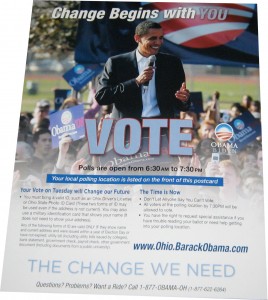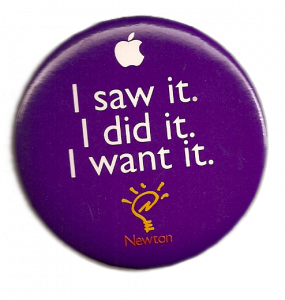This is part of an ongoing series of longer articles I will be posting every Sunday.
This is not a political blog, and this will not be a political post. But there is something to be learned about marketing from the way that political campaigns market their candidates, and this is a lesson for all time.
Watching the polls on FiveThirtyEight, the push and pull between moonbats and wingnuts on Electicker, and the strongly opposed views expressed in the letters to the editor section of my local paper, I began to ask myself how two obviously different candidates could be so close in the polls. Are Americans really divided almost equally between these two men, their running mates, and their platforms? How can so many people want the old senator and the unqualified governor? How can so many want the pairing of un-American and crazy senators?
I began comparing them to Coke and Pepsi, McDonald’s and Burger King, and I realized I was right. These candidates are marketed with extreme precision to maximize their appeal to the widest set of American voters. I imagine that their intrinsic qualities could eliminate them from consideration for some and cement their appeal to others, but the bulk of the electorate is swinging on the messaging. And this simple fact explains why Obama/Biden is now leading against McCain/Palin.
Demicans and Republicrats?
Sometimes, during election time, the candidates speeches can seem to be eerily similar. This was especially the case at the debates, where both Obama and McCain hit the same notes, made the same points, and seemed to be delivering the same messages: Change, fairness, helping the economy, foreign policy strength, and energy independence.
A reasonable person could easily have seen their own beliefs reflected in either candidate. And as in every election, roughly half of all Americans seem to be rooting for one candidate, and half for the other. Are we really divided, red versus blue, or is there something else at work here?
Now let us consider the stump speeches, conventions, and deeper conversations that each candidate has had. Although they pander to their listeners, as was made plain recently, with Obama praising both the Tampa Bay Rays and Philadelphia Phillies, and Palin rooting for these two as well as the Boston Red Sox, they also try to draw out distinctions.
These candidates are very much not the same. Their views differ greatly on major issues of the day, from tax structures to international relations to energy. A thoughtful listener hears a message of trickle-down economics versus lower- and middle-class support, of hawkishness versus engagement, and of increased supply versus alternatives and conservation from McCain and Obama, respectively. Nowhere is the difference more apparent than in the health plans of the two candidates: One is decidedly free-market while the other is government-driven.
Marketing takeaway: Sometimes, two products with distinct and meaningful differences can be so cleverly positioned that some rational people can’t tell them apart!
Going Negative

But these issues don’t get as much coverage as hot buttons like abortion, gay rights, and civil liberties. And nothing wins like pointing out the negatives of the other guy.
Carefully-selected name-calling seems to be the tactic of choice: Palin and McCain are careful to not exactly call Obama a communist, a terrorist, or a non-American, but their speeches seem to leave their listeners with these impressions. Similarly, Obama and Biden have been using words like “erratic” to draw a conclusion from the listener that McCain is senile, and thus too old to be president, or even downright crazy.
The Obama side has been carefully tiptoeing around questioning McCain’s age, just as the McCain side has been with the fact that Obama is black. Neither wants to come out and say these things for fear of alienating voters, but both wants to plant the seed in the listener’s mind. This is especially true when the other guy or his fans slip up, like Murtha’s “racist area” comment or the shouts of Republican rally attendees.
Marketing takeaway: Negative positioning of a competing product can take many forms, from blatant attacks to subtle “meme implants”, but the overt messaging of true believers can be much more damaging!
Feedback Loop
The exhaustive coverage of polling at Pollster, RealClearPolitics, and especially FiveThirtyEight really boggles the mind. I’m something of a math nut, so Nate Silver’s explanations of the intricacies of political polling has been a blast to watch unfold. The mechanics of polling vary somewhat and are prone to error, but the combination of these different polls becomes a powerful predictor of the future. And I’m not the only one watching!
Each campaign has its own poll watchers and spin masters, and these are constantly reacting to up-to-the-minute feedback from the voters. Not only are they dissecting the 40 or so polls that we see, they are commissioning their own polls to figure out how one issue or another can be positioned to maximize their appeal. It’s a tug of war between two slick machines. American national politics is like the Segway two-wheeled scooter – constantly taking input from the tilt sensors to keep it perfectly balanced.
Marketing takeaway: When powerful opposing forces have the same data, it’s easy to play to a draw!
Winning

One would think that these well-funded and informed campaigns would always reach a stalemate, and indeed national polls routinely show a near-even split between Obama and McCain, just as they do nearly every year. Yet, most elections are called fairly decisively, and this year is tilting strongly towards Obama.
How can this be? Simply put, it is not public opinion that declares a winner. No amount of positioning can force a consumer to buy a car he can’t afford – he has to decide to go out there and buy it. Analysis of past elections shows that elections are normally decided based on the enthusiasm behind a candidate rather than the general opinion of the electorate. Democrats weren’t all that enthusiastic about Kerry, Gore, Dukakis, Mondale, and the rest, just as Republicans weren’t too enthusiastic about George H. W. Bush and Bob Dole.
And yes, Republicans really aren’t all that energized by John McCain, either. Sure, they’d like him to win. And yes, they don’t want the un-American socialist in office. But if it wasn’t for Palin, they wouldn’t even be bothering with the man many Republicans have long regarded with scorn as a traitor and outsider to their party.
Contrast this with the fire in the Obama supporters. They love him even more than the right loves Palin, and that’s really saying something! Most analysts expect a strong pro-Obama turnout on Tuesday and expect it will match the pro-Bush, pro-Clinton, and pro-Reagan partisan turnout. Although the margin will still be close due to habitual voters on both sides, this push for the candidate should be enough to ensure victory.
Marketing takeaway: Don’t mistake desire for a sale – your customers can’t just like what you’re selling or dislike what the other guy offers, they have to be willing to buy!
What We Can Learn
I think this election cycle has a lot to teach us, both as marketers and consumers. And in the end, both buyer and seller have to be wary of the tactics used to play the game.
- Keep your eye on the ball! Don’t assume that the intrinsic qualities of a product, service, or person will drive success. People tend to overlook the forest and concentrate on the trees, deciding based on small and even inconsequential features rather than large and rational factors.
- Watch what others are saying for and against you! It’s hard to control word of mouth, and it’s much easier to plant a seed of doubt than prove virtue.
- Butting heads results in a draw! In a game between two equal foes, no amount of effort will force victory.
- Play for victory, not just success! As in sports, a good defense is a requirement, but you’ll never win without a risky drive to score.
- Marketing lessons from the US election by Seth Godin
- Ten marketing lessons from the Barack Obama Presidential campaign by David Meerman Scott
- Election Day Marketing 2008 by The Rogue Marketer
- Marketing – Obama style is winning style by Results Revolution
- Simple by Timothy Coote

Leave a Reply